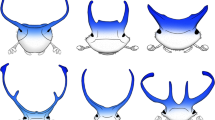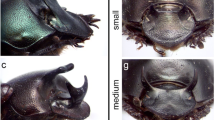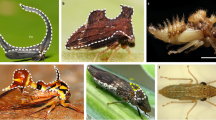Abstract
Beetle horns represent an evolutionary novelty exhibiting remarkable diversity above and below the species level. Here, we show that four typical appendage patterning genes, extradenticle (exd), homothorax (hth), dachshund (dac), and Distal-less (Dll) are expressed in the context of the development of sexually dimorphic thoracic horns in three Onthophagus species. At least two of these genes, Dll and hth, exhibited expression patterns consistent with a conservation of patterning function during horn development relative to their known roles in the development of insect legs. exd, hth, and dac expression patterns during horn development were largely invariable across species or sexes within species. In contrast, Dll expression was far more discrete and exhibited consistent differences between sexes and species. Most importantly, differences in location and domain size of Dll expression tightly correlated with the degree to which prepupal horn primordia were retained or resorbed before the final adult molt. Our results lend further support to the hypothesis that the origin of beetle horns relied, at least in part, on the redeployment of already existing developmental mechanisms, such as appendage patterning processes and that changes in the exact location and domain size of Dll expression may represent important modifier mechanisms that modulate horn expression in different species or sexes. If correct, this would imply that certain components of genetic basis of horn development may be able to diversify rapidly within lineages and largely independent of phylogenetic distance. We present a first model that integrates presently available data on the genetic regulation of horn development and diversity.







Similar content being viewed by others
References
Abu-Shaar M, Mann RS (1998) Generation of multiple antagonistic domains along the proximodistal axis during Drosophila leg development. Development 125:3821–3830
Angelini D, Kaufman TC (2005) Insect appendages and comparative ontogenetics. Dev Biol 286:57–77
Aspland SE, White RAH (1997) Nucleocytoplasmic localisation of extradenticle protein is spatially regulated throughout development in Drosophila. Development 124:741–747
Arrow GH (1951) Horned beetles. Junk Publishers, The Hague
Beermann A, Jay DG, Beeman RW, Hulskamp M, Tautz D, Jurgens G (2001) The Short antennae gene of Tribolium is required for limb development and encodes the orthologue of the Drosophila Distal-less protein. Development 128:287–297
Beldade P, Brakefield PM (2002) The genetics and evo–devo of butterfly wing patterns. Nat Rev Genet 3:442–452
Campbell G (2002) Distalization of the Drosophila leg by graded EGF-receptor activity. Nature 418:781–785
Davidson EH, Erwin DH (2006) Gene regulatory networks and the evolution of animal body plans. Science 311:796–800
Davis RJ, Shen WP, Heanue TA, Mardon G (1999) Mouse Dach, a homologue of Drosophila dachshund, is expressed in the developing retina, brain and limbs. Dev Genes Evol 209:526–536
Emlen DJ (2000) Integrating development with evolution: a case study with beetle horns. Bioscience 50:403–418
Emlen DJ, Nijhout HF (1999) Hormonal control of male horn length dimorphism in the dung beetle Onthophagus taurus (Coleoptera: Scarabaeidae). J Insect Physiol 45:45–53
Emlen DJ, Hunt J, Simmons LW (2005a) Evolution of sexual dimorphism and male dimorphism in the expression of beetle horns: phylogenetic evidence for modularity, evolutionary lability, and constraint. Am Nat 166:S42–S68
Emlen DJ, Marangelo J, Ball B, Cunningham CW (2005b) Diversity in the weapons of sexual selection: horn evolution in the beetle genus Onthophagus (Coleoptera: Scarabaeidae). Evolution 59:1060–1084
Fristrom D, Fristrom JW (1993) The metamorphic development of the adult epidermis. In: Bate M, Arias AM (eds) The development of Drosoplila melanogaster. Cold Spring Harbor Laboratory, Cold Spring Harbor, pp 843–897
Gilbert SF (2001) Ecological developmental biology meets the real world. Dev Biol 233:1–12
Henikoff S, Henikoff JG (1992) Amino acid substitution matrices from protein blocks. PNAS 89:10915–10919
Klingler M, Gergen JP (1993) Regulation of runt transcription by Drosophila segmentation genes. Mech Dev 43:3–19
Kojima T (2004) The mechanism of Drosophila leg development along the proximodistal axis. Dev Growth Differ 46:115–129
Kurant E, Pai CY, Sharf R, Halachmi N, Sun YH, Salzberg A (1998) Dorsotonals/homothorax, the Drosophila homologue of meis1, interacts with extradenticle in patterning of the embryonic PNS. Development 125:1037–1048
Lecuit T, Cohen SM (1997) Proximal–distal axis formation in the Drosophila leg. Nature 388:139–145
Miyawaki K, Inoue Y, Mito T, Fujimoto T, Matsushima K, Shinmyo Y, Ohuchi H, Noji S (2002) Expression patterns of aristaless in developing appendages of Gryllus bimaculatus (cricket). Mech Dev 113:181–184
Moczek AP (2005) The evolution and development of novel traits, or how beetles got their horns. BioScience 11:935–951
Moczek AP (2006a) Integrating micro- and macroevolution of development through the study of horned beetles. Heredity (in press)
Moczek AP (2006b) Developmental plasticity and the origins of diversity: a case study on horned beetles. In: Ananthakrishnan TN, Whitman D (eds) Phenotypic plasticity in insects: mechanisms and consequences. Science, Plymouth, UK
Moczek AP, Nagy LM (2005) Diverse developmental mechanisms contribute to different levels of diversity in horned beetles. Evol Dev 7:175–185
Nagy LM, Williams TA (2001) Comparative limb development as a tool for understanding the evolutionary diversification of limbs in arthropods: challenging the modularity paradigm. In: Wagner G (ed) The character concept in evolutionary biology. Academic, San Diego, CA, USA
Niitsu S (2001) Wing degeneration due to apoptosis in the female of winter moth Nyssiodes lefuarius (Lepidoptera, Geometridae). Entomol Sci 4:1–7
Panganiban G, Nagy L, Carroll SB (1994) The role of the Distal-less gene in the development and evolution of insect limbs. Curr Biol 4:671–675
Panganiban G, Irvine SM, Lowe C, Roehl H, Corley LS, Sherbon B, Grenier JK, Fallon JF, Kimble J, Walker M, Wray GA, Swalla BJ, Martindale MQ, Carroll SB (1997) The origin and evolution of animal appendages. PNAS 94:5162–5166
Pearson WR (1991) Searching protein-sequence libraries: comparison of the sensitivity and selectivity of the Smith–Waterman and FASTA algorithms. Genomics 11:635–650
Prpic NM, Wigand B, Damen WG, Klingler M (2001) Expression of dachshund in wild-type and Distal-less mutant Tribolium corroborates serial homologies in insect appendages. Dev Genes Evolution 211:467–477
Raff R (1996) The shape of life. University of Chicago Press, Chicago, USA
Sameshima SY, Miura T, Matsumoto T (2004) Wing disc development during caste differentiation in the ant Pheidole megacephala (Hymenoptera: Formicidae). Evol Dev 6:336–341
Schlichting CD, Pigliucci M (1998) Phenotype evolution: a reaction norm perspective. Sinauer Associates, Sunderland, MA
Schneitz K, Spielmann P, Noll M (1993) Molecular genetics of aristaless, a prd-type homeobox gene involved in the morphogenesis of proximal and distal pattern elements in a subset of appendgaes in Drosophila. Genes Dev 16:114–129
Schoppmeier M, Damen WGM (2001) Double-stranded RNA interference in the spider Cupiennius salei: the role of Distal-less is evolutionarily conserved in arthropod appendage formation. Dev Genes Evol 211:76–82
Swofford DL (2003) PAUP 4.0 b10: Phylogenetic analysis using parsimony (*and other methods). Version 4. Sinauer Associates, Sunderland, Massachusetts
Tavsanli BC, Ostrin EJ, Burgees HK, Middlebrooks BW, Pham TA, Mardon G (2004) Structure-function analysis of the Drosophila retinal determination protein Dachshund. Dev Biol 272:231–247
Tautz D, Pfeifle C (1989) A non-radioactive in situ hybridization method for the localization of specific RNAs in Drosophila embryos reveals translational control of the segmentation gene hunchback. Chromosoma 98:81–85
Thompson JD, Higgins DG, Gibson TJ (1994) CLUSTAL W: improving the sensitivity of progressive multiple sequence alignment through sequence weighting, position-specific gap penalties and weight matrix choice. Nucleic Acids Res 22:4673–4680
True JR, Carroll SB (2002) Gene co-option in physiological and morphological evolution. Annu Rev Cell Dev Biol 18:53–80
West-Eberhard MJ (2003) Developmental plasticity and evolution. Oxford University Press, New York
Wu J, Cohen SM (1999) Proximodistal axis formation in the Drosophila leg: subdivision into proximal and distal domains by homothorax and distal-less. Development 126:109–117
Zera AJ, Zhang CQ (1995) Evolutionary endocrinology of juvenile hormone esterase in Gryllus assimilis: direct and correlated responses to selection. Genetics 141:1125–1134
Zijlstra WG, Steigenga MJ, Koch PB, Zwaan BJ, Brakefield PM (2004) Butterfly selected lines explore the hormonal basis of interactions between life histories and morphology. Am Nat 163:76–87
Acknowledgements
Lisa Nagy provided important advice and guidance throughout this project and helpful comments on earlier versions of this manuscript. Comments from two anonymous reviewers also greatly helped to improve the manuscript. C. Jacobson and J. Micantin expertly located and collected beetles in the field. Antibodies used in this study were generously provided by G. Boekhoff-Falk (DLL), A. Salzberg (HTH) and R. A. H. White (EXD). Matthew Terry assisted with the phylogenetic analyses. Funding was provided by NSF Grant IOB 0445661 to APM. BRK was supported through NIH Genetics Training Grant (NIH-NIGMS T32-GM007757-27) and WS was supported through NSF Grant 10B-0236193.
Author information
Authors and Affiliations
Corresponding author
Additional information
Communicated by S. Roth
Rights and permissions
About this article
Cite this article
Moczek, A.P., Rose, D., Sewell, W. et al. Conservation, innovation, and the evolution of horned beetle diversity. Dev Genes Evol 216, 655–665 (2006). https://doi.org/10.1007/s00427-006-0087-2
Received:
Accepted:
Published:
Issue Date:
DOI: https://doi.org/10.1007/s00427-006-0087-2




